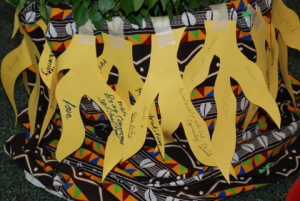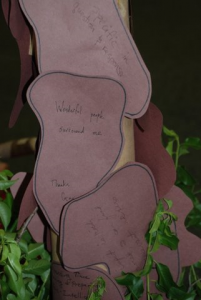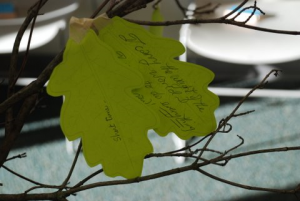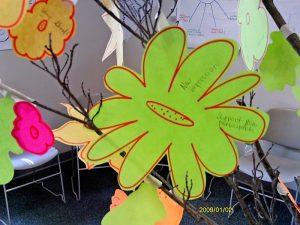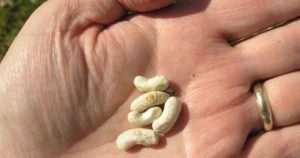Jul 31, 2014
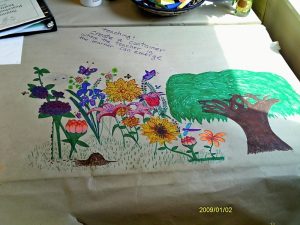 The above image was drawn on one of our tables by a participant over the period of our 7-day course.
The above image was drawn on one of our tables by a participant over the period of our 7-day course.
Last week we had the honor of teaching the course Designing Learner-Centered Training for Conflict Transformation at the Summer Peacebuilding Institute (SPI) at Eastern Mennonite University located in Harrisonburg, Virginia. Each year the students gather from around the world, the courses are cutting edge and provocative, and the professors are leaders and activists in the area of peacebuilding, restorative justice and conflict transformation. Most of our students are active practitioners in these areas and we were there to teach how to design learning events for their work and to consistently model learner-centered education (what we call Dialogue Education).
One of the most moving aspects of this course for us and the learners was our use of metaphor. Every day we created the space for a 30-minute reflection using a tree as a metaphor to consider our journey as learners and teachers in the course. Excuse our boldness, but no teacher-centered classroom could have produced the depth of heart-felt reflection, introspection or sharing as this learner-centered approach allowed and invited with this task. Many days we ended our time in silence after each of us had an opportunity to share.
Here are the learning tasks describing how we used the metaphor in our 7-day course:
| Day 1: Come Plant a Seed! (Task 7) |
|
7A. Select a seed from the basket that will be passed around the circle and hold it in the palm of your hand. 7B. Reflect silently on the attributes of a seed, and then compare the seed to the learning process you experienced today. 7C. Interview your partner and ask each other the following questions. · What new “seeds” have been planted in you today about learners and the learning process?
7D. You will be invited to come plant your seed. If you wish, you may choose to share a thought with the rest of the class. Feel free to leave in silence when you wish after everyone is finished. |
| Day 2: Grounded (Task 17) |
|
17A. Choose a partner with whom you feel comfortable. Stand face-to-face with your partner at arm’s length. One at a time and when you are ready, gently push each other with two hands on the shoulders. Describe the sensation and feeling of being pushed and loosing your balance. 17B. Stand again in the same manner. Close your eyes and listen to the tree meditation. One at a time, again attempt to push each other at the top of the breast bone. Listen to the meditation again to become un-rooted. 17C. Interview your partner. a. How was the first experience similar or different from the second? b. What does it feel like to be grounded physically and how does it compare to be grounded in other ways? c. What roots do you think you need to strengthen to ground yourself with greater firmness as a dialogue practitioner? d. What are some of your core values that keep you grounded as you stretch to grow and learn? How do you think you, as a facilitator show respect for the core values that learners have in a classroom or workshop?
17D. Write those things that keep you grounded on the paper roots provided. If you wish, you may share some of your words as you place your roots around our large basket. Feel free to leave in silence when you wish after everyone is finished. |
| Day 3: Willow in the Wind (Task 25) |
|
25A. Gather in a circle. Listen, observe, and practice the instructions on how to be part of the forest and how to be a willow tree. 25B. Re-gather in groups of six to carry out the activity and choose a group leader. 25C. Still in the groups of six, ask each other the following questions: 1) How did it feel to be part of the “forest”? 2) How did it feel to be a “willow tree”? 3) Who and what makes up the “forest” of your life? 4) What insights have you today or this week that will strengthen your confidence in yourself or in others?
25D. Write your insights on a strip of paper bark and share what you wrote if you wish. Feel free to leave in silence when you wish after everyone is finished. |
| Day 4: The Problem Tree (Task 33) |
|
33A. Listen to the story about “the problem tree”. 33B. Identify some of the problems and challenges you are facing in the design process and write them down on the leaves provided. 33C. Describe the problems and challenge as you see them to your partner of three and brainstorm briefly together about some of the resources you might need to solve the problems or meet the challenges. 33D. As a sign of support in the midst of the challenges of design, your partner will tape your leaves to the class tree while briefly describing one of the problems or challenges you identified. You will tape your partner’s leaves to the tree and describe a problem or challenge. Feel free to leave in silence when you wish after everyone is finished. |
| Day 5: Flowers of Enjoyment (Task 40) |
|
40A. Reflect on those things you have most enjoyed during your time at SPI and in this class so far by asking yourself the following questions. Write key words down on the paper petals provided to remind you of what you have enjoyed. 1) What “flowers” have burst into bloom for you since you have been here? 2) What special things have happened that you would like to remember when you leave SPI? 40B. Choose a flower and a piece of tape. Write these special thinks on the petals of your flower. 40C. If you wish, share what you wrote as you are attaching it to our tree. Feel free to leave in silence when you wish after everyone is finished. |
| Day 6: Beyond the Wrapping (Task 49) |
|
49A. Choose a piece of fruit candy from the basket. 49B. On your own, dream about the fruits or results of the design you are now preparing and getting ready to try out. What do you think they will be like? 49D. Savor these fruits of your labour. If you wish, share your thoughts with the group as you attach your candy. Feel free to leave in silence when you wish after everyone is finished. |
| Day 7: New Seeds! (Task 56) |
|
Personal Reflection time 56A. As you look at our tree now, reflect on your learning for each day during this course. Recall when the seed of the class was planted, when the roots grew down deep, when the trunk of new friendships developed, when problems sprouted like leaves, when the enjoyable moments flowered, when you envisioned the fruits of your design… 56B. Name your feelings as this class comes to an end. 56C. Decide on a personal or professional commitment you would like to make as this class ends. You might, for example, commit to exploring new ways to use Dialogue Education in your work, to practicing a particular skill, or to respecting the different learning styles of your family members. Group Reflection time 56D. The tree of our class has matured and is now dropping some of its seeds, readying itself to spread new life. Brainstorm what new things you think will grow out of the experiences in class and during SPI this session. 56E. Select another seed from the ones on the ground around our maturing tree. Through a circle process, those who wish to voice their personal or professional commitment to the class may do so. 56F. Anyone who wishes to take any parts of the tree with them to remind them of this commitment may do so. Feel free to leave in silence when you wish after everyone is finished. |
Of course there was a fair amount of preparation time for these tasks: bringing in a pot, sand, seeds, branches, candy; cutting paper roots, leaves, and flowers; as well as, making and protecting a circle of chairs around the tree. However, it was worth it! The tree put the “sacred” in learning, “beauty” in the classroom, and “mystery” in a group of learners. Learner-centered education creates the space for all this, where learning could be deeply personal, wonderfully surprising, and playfully moving. We left each day exhausted and amazed at what had gone on.
During our seven days with this remarkable group of learners, both of us were touched by everyone’s personal commitments to peace and the ways in which they each served as “teachers” for each other. The sights and sounds of learners from different countries, religions and cultures working in pairs to design their individual learning events was moving and inspiring. Despite these differences, a tree which grew from seed to mature growth and eventual renewal, helped to unite us all at the end of each day. And, we all left with real seeds to symbolize our commitment to using our newly-discovered tools in their work, relationships and life.
NOTE: The metaphor described above was originally created by Elena Huegel at Centro Shalem, who co-taught the course with Robb Davis at the Summer Peacebuilding Program (SPI) in 2005. She felt that the course needed a deeply “affective thread” that could more tightly weave the learners to each other, their learning and their journey in the class. She was right and we are grateful for her wisdom each time this course is taught. Since then she has incorporated this metaphor and the corresponding activities into her a learner-centered manual for environmental education teachers called “Estrategias Innovadoras para la Educación Ambiental” (in English: “Innovative Strategies for Environmental Education”) to be used by the Centro Shalom in Chile in conjunction with the Universidad Católica del Maule (October 2005). She co-wrote this manual with Carol Verdugo.
Jeanette Romkema and Marshall Yoder are instructors at the Summer Peacebuilding Institute, Eastern Mennonite University. You can contact them with your questions at jeanette@globallearningpartners.com and paul.m.yoder@emu.edu.




